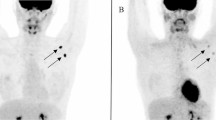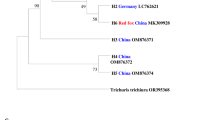Abstract
Distinct sequences of Giardia duodenalis assemblages raised the hypothesis that certain assemblages may contribute to its clinical outcome. However, sequences analysis is time consuming, expensive, and needs many manual operations. Nested PCR targeting intergenic spacer (IGS) region was applied successfully to genotype G. duodenalis. This study aimed to identify the prevalence of G. duodenalis assemblages among giardiasis school children and its relation to the presence of symptoms using nested IGS/PCR. Of 65 microscopically confirmed Giardia-positive samples, 65 samples were genotyped proving high sensitivity (92.3%) of IGS/PCR. Negative IGS/PCR samples were also negative for β-giardin gene. Subassemblage AI was the commonest with 66.6% (20/30) among asymptomatic children compared to 53.3% (16/30) of symptomatic, while assemblage B was found in 40% (12/30) of symptomatic compared to 20% (6/30) of asymptomatic. The difference was significant. AII was only found in asymptomatic with 13.4% (4/30), while mixed infections (AI&B) were recorded only in 6.6% (2/30) of symptomatic group. A significant relation was found between younger children susceptibility for AI and B infections as presented in 77.7 (12/16) and 83.3% (10/12) of symptomatic, respectively, and 80 (16/80) and 33.4% (2/4) of asymptomatic, respectively. Significant relations were found between AI with intermittent diarrhea and B with chronic. A significant relation was found between assemblage distributions and heavy infection intensity. In conclusion, higher incidence of assemblage B among symptomatic children compared to asymptomatic could denote its possible pathogenic potential.

Similar content being viewed by others
References
Abdel-Moneim S, Sultan D (2008) Genetic characterization of Giardia lamblia isolates from Egyptian patients with relation to clinical giardiasis. J Egypt Soc Parasitol 38(2):547–560
Almedia NA, Delgado ML, Soares SC, Castro AN, Moreira MJ, Mendonc CM, Canada NB, Da Costa J (2006) Genotype analysis of Giardia isolated from asymptomatic children in Northern Portugal. J Eukaryot Microbiol 53:177–178
Al-Mekhlafi MS, Azlin M, Nor Aini U, Shaik A, Sa’iah A, Fatmah MS, Ismail MG, Ahmad Firdaus MS, Aisah MY, Rozlida AR, Norhayati M (2005) Giardiasis as a predictor of childhood malnutrition in Orang Asli children in Malaysia. Trans R Soc Trop Med Hyg 99(9):686–691
Al-Mohammed HI (2011) Genotypes of Giardia intestinalis clinical isolates of gastrointestinal symptomatic and asymptomatic Saudi children. Parasitol Res 108(6):1375–1381
Alyousefi N, Mahdy M, Xiao L, Mahmud R, Lim Y (2013) Molecular characterization of Giardia duodenalis in Yemen. Exp Parasitol 134(2):141–147
Andrews RH, Monis PT, Ey PL, Mayrhofer G (1998) Comparison of the level of intra-specific genetic variation within Giardia muris and Giardia intestinalis. Int J Parasitol 28:1179–1185
Ankarklev J, Jerlstrom-Hultqvist J, Ringqvist E, Troell K, Sv SG (2010) Behind the smile: cell biology and disease mechanisms of Giardia species. Nat Rev Microbiol 8:413–422
Aydin AF, Besirbellioglu BA, Avci IY, Tanyuksel M, Araz E, Pahsa A (2004) Classification of Giardia duodenalis parasites in Turkey into groups A and B using restriction fragment length polymorphism. Diagn Microbiol Infect Dis 50:147–151
Babaei Z, Malihi N, Zia-Ali N, Sharifi I, Mohammadi M, Kagnoff M, Eckmann L, Singer S, Solaymani-Mohammadi S (2016) Adaptive immune response in symptomatic and asymptomatic enteric protozoal infection: evidence for a determining role of parasite genetic heterogeneity in host immunity to human giardiasis. Microbes Infect 18:687–695
Bayoumy AM, Mohammed KA, Shahat SA, Ghannam MM, Gazy Mel S (2010) Role of parasites among chronic diarrheic patients. J Egypt Soc Parasitol 40:679–698
Centre for Disease Control and Prevention (2011) Hygiene-related diseases, hygiene, healthy water, CDC http://www.cdc.gov/healthywater/hygiene/disease/chronic_diarrhea.html. Accessed 20 Dec 2015
Cheesbrough M (2003) Examination of faecal specimens. In: District laboratory practice in tropical countries, 2nd edn. part 2. Cambridge University Press, United Kingdom, p 97–105
Cotton JA, Beatty JK, Buret AG (2011) Host parasite interactions and pathophysiology in Giardia infections. Int J Parasitol 41(9):925–933
Ehsan AM, Geurden T, Casaert S, Parvin SM, Islam TM, Ahmed UM, Levecke B, Vercruysse J, Claerebout E (2015) Assessment of zoonotic transmission of Giardia and Cryptosporidium between cattle and humans in rural villages in Bangladesh. PLoS One 10(2):e0118239
El Basha N, Zaki M, Hassanin O, Rehan M, Omran D (2016) Giardia assemblages A and B in diarrheic patients: a comparative study in egyptian children and adults. J Parasitol 102(1):69–67
El Fatni C, Olmo F, El Fatni H, Romero D, Rosales MJ (2014) First genotyping of Giardia duodenalis and prevalence of enteroparasites in children from Tetouan (Morocco). Parasite 21:48
Fahmy HM, El-Serougi AO, El Deeb HK, Hussein HM, Abou-Seri HM, Klotz C, Aebischer T, Khalifa ES, Mohamed K (2015) Giardia duodenalis assemblages in Egyptian children with diarrhea. Eur J Clin Microbiol Infect Dis 34(8):1573–1581
Feng Y, Xiao L (2011) Zoonotic potential and Moecular epidemiology of Giardia species and giardiasis. Clinical Microbiology Review 24:110–140
Flecha MJ, Benavides CM, Tissiano G, Tesfamariam A, Cuadros J, de Lucio A, Bailo B, Cano L, Fuentes I, Carmena D (2015) Detection and molecular characterisation of Giardia duodenalis, Cryptosporidium spp. and Entamoeba spp. among patients with gastrointestinal symptoms in Gambo Hospital, Oromia Region, southern Ethiopia. Tropical Med Int Health 20(9):1213–1222
Garcia LS (2007) Diagnostic Medical Parasitology, 5th edn. ASM Press, Washington DC, pp. 60–105
Gelanew T, Lalle M, Hailu A, Pozio E, Caccio SM (2007) Molecular characterization of human isolates of Giardia duodenalis from Ethiopia. Acta Trop 102:92–99
Ghosh S, Debnath A, Sil A, De S, Chattopadhyay J, Das P (2000) PCR detection of Giardia lamblia in stool: targeting intergenic spacer region of multicopy of rRNA gene. Mol Cell Probes 14:181–189
Helmy MM, Abdel-Fattah HS, Rashed L (2009) Real-time PCR/RFLP assay to detect Giardia intestinalis assemblages in human isolates with diarrhea in Egypt. J Parasitol 95:1000–1004
Helmy YA, Klotz C, Wilking H, Krücken J, Nöckler K, Von Samson-Himmelstjerna G, Zessin KH, Aebischer T (2014) Epidemiology of Giardia duodenalis infection in ruminant livestock and children in the Ismailia province of Egypt: insights by genetic characterization. Parasit Vectors 7:321
Heyworth M (2016) Giardia duodenalis genetic assemblage and host. Parasite 23:13
Homan WL (1992) Comparison of Giardia isolates from different laboratories by isoenzymes analysis and recombinant DNA probes. Parasitol Res 78:316–323
Homan WL, Mank TG (2001) Human giardiasis: assemblage linked differences in clinical symptomatology. Int J Parasitol 31:822–826
Hove RJ, Esbroeck M, Ende J, Lieshout L, Nooyen R, Verweij JJ (2013) Molecular epidemiology of Giardia lamblia in travelers. In: The parasitologist. http://www.theparasitologist.com/chapter-5-molecular-epidemiology-of-giardia-lamblia-in-travellers/ Accessed 20 Dec 2015
Huey CS, Mahdy MA, Al-Mekhlafi HM, Nasr NA, Lim YA, Mahmud R, Surin J (2013) Multilocus genotyping of Giardia duodenalis in Malaysia. Infect Genet Evol 17:269–276
Huston CD (2006) Fordtran’s gastrointestinal and liver disease. In: Feldman M, Friedman LS, Brandt LJ (eds) Intestinal protozoa, 8th edn. Saunders, Philadelphia, an imprint of Elsevier Inc, 2420–2423/106. Accessed 20 Dec 2015
Karanis P, Ey P (1998) Characterization of axenic isolates of Giardia intestinalis established from humans and animals in Germany. Parasitol Res 84:442–449
Kohli A, Bushen OY, Pinkerton RC, Houpt E, Newman RD, Sears CL, Lima AA, Guerrant RL (2008) Giardia duodenalis assemblage, clinical presentation and markers of intestinal inflammation in Brazilian children. Trans R Soc Trop Med Hyg 102:718–725
Laishram S, Kang G, Ajjampur SSR (2012) Giardiasis: a review on assemblage distribution and epidemiology in India. Indian J Gastroenterol 31(1):3–12
Lalle M, Jimenez-Cardosa E, Cacciò S, Pozio Source E (2005) Genotyping of Giardia duodenalis from humans and dogs from Mexico using a β-giardin nested polymerase chain reaction assay. J Parasitol 91(1):203–205
Lasek-Nesselquist E, Welch DM, Sogin ML (2010) The identification of a new Giardia duodenalis assemblage in marine vertebrates and a preliminary analysis of G. duodenalis population biology in marine systems. Int J Parasitol 40(9):1063–1074
Lee H, Lee J, Park S, Young T, Hwang U (2006) Detection and genotyping of Giardia intestinalis isolates using intergenic spacer (IGS) based PCR. Korean J Parasitol 44:343–353
Mateo M, Mateo M, Montoya A, Bailo B, Saugar JM, Aguilera M, Fuentes I, Carmena D (2014) Detection and molecular characterization of Giardia duodenalis in children attending day care centers in Majadahonda, Madrid, Central Spain. Medicine (Baltimore) 93(15):e75
Mayrhofer G (1995) Division of Giardia isolates from human into two genetically distinct assemblages by elecropheretic analysis of enzyme encoded at 27 loci and comparison with Giardia muris. Parasitology 111:11–17
Mohammed Mahdy AK, Surin J, Wan KL, Mohd-Adnan A, Al-Mekhlafi MS, Lim YA (2009) Giardia intestinalis genotypes: risk factors and correlation with clinical symptoms. Acta Trop 112(1):67–70
Molina N, Minvielle M, Grenóvero S, Salomón C, Basualdo J (2011) High prevalence of infection with Giardia intestinalis genotype B among children in urban and rural areas of Argentina. Ann Trop Med Parasitol 105(4):299–309
Nash TE, Keister DB (1985) Differences in excretory-secretory products and surface antigens among 19 isolates of Giardia. J Infect Dis 152:1166–1117
Peréz Cordón G, Cordova Paz Soldan O, Vargas Vásquez F, Velasco Soto JR, Sempere Bordes L, Sánchez Moreno M, Rosales MJ (2008) Prevalence of enteroparasites and genotyping of Giardia lamblia in Peruvian children. Parasitol Res 103(2):459–465
Pestechian N, Rasekh H, Rostami-Nejad M, Yousofi HA, Hosseini-Safa A (2014) Molecular identification of Giardia lamblia; is there any correlation between diarrhea and genotyping in Iranian population? Gastroenterol Hepatol Bed Bench 7(3):168–172
Pierce K, Kirkpatrick B (2009) Update on human infections caused by intestinal protozoa. Curr Opin Gastroenterol 25(1):12–17
Plutzer J, Ongerth J, Karanis P (2010) Giardia taxonomy, phylogeny, and epidemiology: Facts and open questions. Int J Hyg Environ Health 213:321–233
Puebla LJ, Núñez FA, Fernández YA, Fraga J, Rivero LR, Millán IA, Valdés LA, Silva IM (2014) Correlation of Giardia duodenalis assemblages with clinical and epidemiological data in Cuban children. Infect Genet Evol 23:7–12
Qader AM, Bakir TY (2011) Molecular identification of Giardia duodenalis parasite isolated from human by polymerase chain reaction-restriction fragment length polymorphism technique (PCR-RFLP) in Baghdad Province Diyala. Journal for Pure Science 7(4):54–66
Rafiei A, Roointan ES, Samarbafzadeh AR, Shayesteh AA, Shamsizadeh A, Pourmahdi B (2013) Investigation of possible correlation between Giardia duodenalis genotypes and clinical symptoms in southwest of Iran. Iran J Parasitol 8(3):389–395
Read C, Walters J, Robertson LD, Thompson RC (2002) Correlation between genotype of Giardia duodenalis and diarrhoea. Int J Parasitol 32:229–231
Robertson LJ, Hanevik K, Escobedo AA, Morch K, Langeland N (2010) Giardiasis—why do the symptoms sometimes never stop? Trends Parasitol 26:75–82
Sahagun J, Clavel A, Goni P, Seral C, Llorente MT, Castillo FJ, Capilla S, Arias A, Gomez-Lus R (2008) Correlation between the presence of symptoms and the Giardia duodenalis genotype. Eur J Clin Microbiol Infect Dis 27:81–83
Savioli L, Smith H, Thompson A (2006) Giardia and Cryptosporidium join the ‘neglected diseases initiative. Trends Parasitol 22:203–208
Sil K, Das P, Bhattacharyya S, Ghosh S, Chattopadhyay J (1998) Cloning of ribosomal RNA genes from Indian isolate of Giardia lamblia and the use of intergenic non transcribing spacer regions in the differentian of Giardia from other enteric pathogens. J Biosci 23(5):557–564
Soliman RH, Fuentes I, Rubio JM (2011) Identification of a novel assemblage B subgenotype and a zoonotic assemblage C in human isolates of Giardia intestinalis in Egypt. Parasitol Int 60(4):507–511
Tak V, Mirdha BR, Yadav P, Vyas P, Makharia GK, Bhatnagar S (2014) Molecular characterisation of Giardia intestinalis assemblages from human isolates at a tertiary care centre of India. Indian J Med Microbiol 32(1):19–25
Tamer GS, Kasap M, Er DK (2015) Genotyping and phylogenetic analysis of Giardia duodenalis isolates from Turkish children. Med Sci Monit 21:526–532
WHO (2013) Diarrhoeal disease. http://www.who.int/mediacentre/factsheets/fs330/en/ Accessed 20 Dec 2015
Younas M, Shah S, Talaat A (2008) Frequency of Giardia intestinalis infection in children with recurrent abdominal pain. J Pak Med Assoc 58:171–174
Author information
Authors and Affiliations
Corresponding author
Ethics declarations
Funding
All of the authors are sharing on the costs.
Conflict of interest
The authors declare that they have no conflict of interest.
All of the procedures were conducted according to the ethical standard approved by the Human Ethics Committee, Faculty of Medicine, Suez Canal University, Egypt.
Rights and permissions
About this article
Cite this article
Hussein, E.M., Ismail, O.A., Mokhtar, A.B. et al. Nested PCR targeting intergenic spacer (IGS) in genotyping of Giardia duodenalis isolated from symptomatic and asymptomatic infected Egyptian school children. Parasitol Res 116, 763–771 (2017). https://doi.org/10.1007/s00436-016-5347-0
Received:
Accepted:
Published:
Issue Date:
DOI: https://doi.org/10.1007/s00436-016-5347-0




